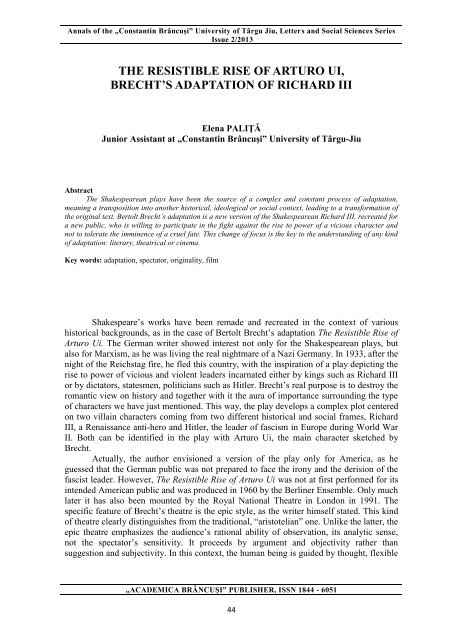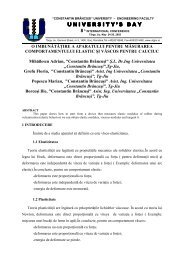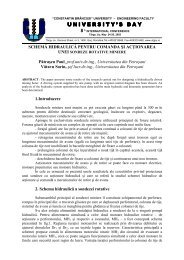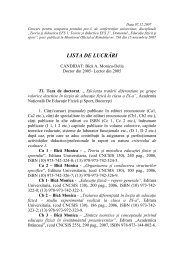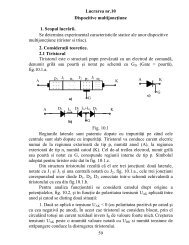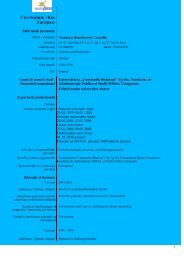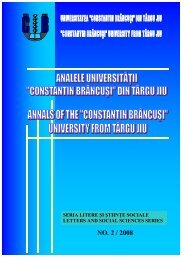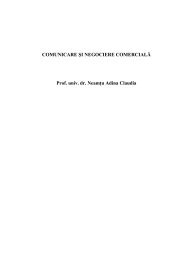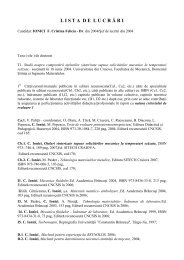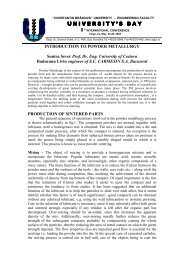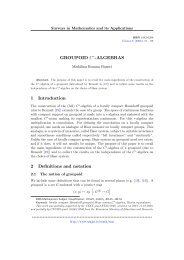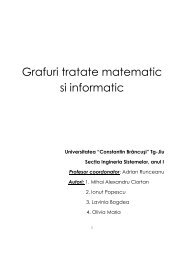the resistible rise of arturo ui, brecht's adaptation of richard iii
the resistible rise of arturo ui, brecht's adaptation of richard iii
the resistible rise of arturo ui, brecht's adaptation of richard iii
You also want an ePaper? Increase the reach of your titles
YUMPU automatically turns print PDFs into web optimized ePapers that Google loves.
Annals <strong>of</strong> <strong>the</strong> „Constantin Brâncuși” University <strong>of</strong> Târgu Jiu, Letters and Social Sciences Series<br />
Issue 2/2013<br />
THE RESISTIBLE RISE OF ARTURO UI,<br />
BRECHT’S ADAPTATION OF RICHARD III<br />
Elena PALIŢĂ<br />
Junior Assistant at „Constantin Brâncuşi” University <strong>of</strong> Târgu-Jiu<br />
Abstract<br />
The Shakespearean plays have been <strong>the</strong> source <strong>of</strong> a complex and constant process <strong>of</strong> <strong>adaptation</strong>,<br />
meaning a transposition into ano<strong>the</strong>r historical, ideological or social context, leading to a transformation <strong>of</strong><br />
<strong>the</strong> original text. Bertolt Brecht’s <strong>adaptation</strong> is a new version <strong>of</strong> <strong>the</strong> Shakespearean Richard III, recreated for<br />
a new public, who is willing to participate in <strong>the</strong> fight against <strong>the</strong> <strong>rise</strong> to power <strong>of</strong> a vicious character and<br />
not to tolerate <strong>the</strong> imminence <strong>of</strong> a cruel fate. This change <strong>of</strong> focus is <strong>the</strong> key to <strong>the</strong> understanding <strong>of</strong> any kind<br />
<strong>of</strong> <strong>adaptation</strong>: literary, <strong>the</strong>atrical or cinema.<br />
Key words: <strong>adaptation</strong>, spectator, originality, film<br />
Shakespeare‟s works have been remade and recreated in <strong>the</strong> context <strong>of</strong> various<br />
historical backgrounds, as in <strong>the</strong> case <strong>of</strong> Bertolt Brecht‟s <strong>adaptation</strong> The Resistible Rise <strong>of</strong><br />
Arturo Ui. The German writer showed interest not only for <strong>the</strong> Shakespearean plays, but<br />
also for Marxism, as he was living <strong>the</strong> real nightmare <strong>of</strong> a Nazi Germany. In 1933, after <strong>the</strong><br />
night <strong>of</strong> <strong>the</strong> Reichstag fire, he fled this country, with <strong>the</strong> inspiration <strong>of</strong> a play depicting <strong>the</strong><br />
<strong>rise</strong> to power <strong>of</strong> vicious and violent leaders incarnated ei<strong>the</strong>r by kings such as Richard III<br />
or by dictators, statesmen, politicians such as Hitler. Brecht‟s real purpose is to destroy <strong>the</strong><br />
romantic view on history and toge<strong>the</strong>r with it <strong>the</strong> aura <strong>of</strong> importance surrounding <strong>the</strong> type<br />
<strong>of</strong> characters we have just mentioned. This way, <strong>the</strong> play develops a complex plot centered<br />
on two villain characters coming from two different historical and social frames, Richard<br />
III, a Renaissance anti-hero and Hitler, <strong>the</strong> leader <strong>of</strong> fascism in Europe during World War<br />
II. Both can be identified in <strong>the</strong> play with Arturo Ui, <strong>the</strong> main character sketched by<br />
Brecht.<br />
Actually, <strong>the</strong> author envisioned a version <strong>of</strong> <strong>the</strong> play only for America, as he<br />
guessed that <strong>the</strong> German public was not prepared to face <strong>the</strong> irony and <strong>the</strong> derision <strong>of</strong> <strong>the</strong><br />
fascist leader. However, The Resistible Rise <strong>of</strong> Arturo Ui was not at first performed for its<br />
intended American public and was produced in 1960 by <strong>the</strong> Berliner Ensemble. Only much<br />
later it has also been mounted by <strong>the</strong> Royal National Theatre in London in 1991. The<br />
specific feature <strong>of</strong> Brecht‟s <strong>the</strong>atre is <strong>the</strong> epic style, as <strong>the</strong> writer himself stated. This kind<br />
<strong>of</strong> <strong>the</strong>atre clearly disting<strong>ui</strong>shes from <strong>the</strong> traditional, “aristotelian” one. Unlike <strong>the</strong> latter, <strong>the</strong><br />
epic <strong>the</strong>atre emphasizes <strong>the</strong> audience‟s rational ability <strong>of</strong> observation, its analytic sense,<br />
not <strong>the</strong> spectator‟s sensitivity. It proceeds by argument and objectivity ra<strong>the</strong>r than<br />
suggestion and subjectivity. In this context, <strong>the</strong> human being is g<strong>ui</strong>ded by thought, flexible<br />
„ACADEMICA BRÂNCUȘI” PUBLISHER, ISSN 1844 - 6051<br />
44
Annals <strong>of</strong> <strong>the</strong> „Constantin Brâncuși” University <strong>of</strong> Târgu Jiu, Letters and Social Sciences Series<br />
Issue 2/2013<br />
and subdued to alteration throughout life, not fixed, at <strong>the</strong> mercy <strong>of</strong> an insurmountable fate.<br />
This background allows an approach between <strong>the</strong> Shakespearean <strong>the</strong>atre and Brecht‟s<br />
work: “Both expose <strong>the</strong> <strong>the</strong>atrical reality behind <strong>the</strong> representational illusion. Both proceed<br />
episodically through a large number <strong>of</strong> scenes. Both portray a broad swath <strong>of</strong> society –<br />
plays by Shakespeare and Brecht have equally large numbers <strong>of</strong> characters. Both present<br />
events from history and engage with questions <strong>of</strong> historical causation.”[1] Ano<strong>the</strong>r aspect<br />
which relates <strong>the</strong> two is Brecht‟s interest in Shakespearean ambig<strong>ui</strong>ties: “There‟s nothing<br />
more stupid than to perform Shakespeare so that he‟s clear. He‟s by his very nature<br />
unclear. He‟s pure material.”[2] Starting with this point, Brecht tries to adapt <strong>the</strong> original<br />
play focusing on clarity and trying to annihilate <strong>the</strong> ambig<strong>ui</strong>ty. His play opens with a<br />
prologue which sustains this idea. It addresses directly <strong>the</strong> audience, presenting <strong>the</strong><br />
characters and explaining <strong>the</strong> plot, stressing <strong>the</strong> message and not <strong>the</strong> suspense <strong>of</strong> what<br />
happens next. From this point <strong>of</strong> view, Brecht‟s play gains a didactic value:<br />
” THE ANNOUNCER Friends, tonight we‟re going to show –<br />
Pipe down, you boys in <strong>the</strong> back row!<br />
And, lady, your hat is in <strong>the</strong> way! –<br />
The great historical gangster play<br />
Containing, for <strong>the</strong> first time, as you‟ll see<br />
The truth about <strong>the</strong> scandalous dock subsidy.<br />
Fur<strong>the</strong>r we give you, for your betterment<br />
Dogsborough‟s confession and testament.<br />
Arturo Ui‟s <strong>rise</strong> while <strong>the</strong> stock market fell.<br />
The notorious warehouse fire trial. What a sell!<br />
The Dullfeet murder! Justice in a coma!<br />
Gang warfare: <strong>the</strong> killing <strong>of</strong> Ernesto Roma!<br />
All culminating in our stunning last tableau:<br />
Gangsters take over <strong>the</strong> town <strong>of</strong> Cicero!”[3]<br />
Brecht uses <strong>the</strong> Chicago setting populated by underworld characters in several <strong>of</strong> his plays,<br />
with <strong>the</strong> purpose to create a sense <strong>of</strong> <strong>the</strong> exotic and fantastic world, establishing a<br />
comforting distance between <strong>the</strong> audience and <strong>the</strong> characters. He clearly alludes to<br />
Shakespeare from <strong>the</strong> very beginning:<br />
“ARTURO UI steps before <strong>the</strong> curtain and walks out along <strong>the</strong> footlights<br />
Doesn‟t he make you think <strong>of</strong> Richard <strong>the</strong> Third?<br />
Has anybody ever heard<br />
Of blood so ghoulishly and lavishly shed<br />
Since wars were fought for roses white and red?<br />
In view <strong>of</strong> this <strong>the</strong> management<br />
Has spared no cost in its intent<br />
To picture his spectacularly vile<br />
Manoeuvres in <strong>the</strong> greatest style.<br />
But everything you‟ll see tonight is true.<br />
Nothing‟s invented, nothing‟s new.<br />
Or made to order just for you.<br />
The gangster play that we present<br />
„ACADEMICA BRÂNCUȘI” PUBLISHER, ISSN 1844 - 6051<br />
45
Annals <strong>of</strong> <strong>the</strong> „Constantin Brâncuși” University <strong>of</strong> Târgu Jiu, Letters and Social Sciences Series<br />
Issue 2/2013<br />
Is known to <strong>the</strong> whole continent.”[4]<br />
The author informs <strong>the</strong> reader or <strong>the</strong> spectator about <strong>the</strong> veridical quality <strong>of</strong> <strong>the</strong> play: every<br />
character has direct counterparts in real life and every scene showing an event can be<br />
connected with a real event. For instance Goodwill and Gaffles, two members <strong>of</strong> <strong>the</strong> city<br />
council can be compared to Rosencrantz and G<strong>ui</strong>ldenstern from Hamlet or <strong>the</strong> large scenes<br />
in which Ui demonstrates his skills at rhetorical oration seem directly lifted from Julius<br />
Caesar.<br />
Going back to <strong>the</strong> resemblance <strong>of</strong> <strong>the</strong> play to Shakespeare‟s Richard III, Brecht‟s<br />
play concludes with a direct call for action after having presented an insurmountable<br />
situation. The spectators are bound to reflect upon <strong>the</strong> possibility <strong>of</strong> a concerted effort that<br />
could help solving <strong>the</strong> situation:<br />
“Therefore learn how to see and not to gape.<br />
To act instead <strong>of</strong> talking all day long.<br />
The world was almost won by such an ape!<br />
The nations put him where his king belong.<br />
But don‟t rejoice too soon at your escape –<br />
The womb he crawled from still is gong strong.”[5]<br />
In <strong>the</strong> o<strong>the</strong>r case, Richard III seems to end in a spirit <strong>of</strong> destiny inevitability, as if fate<br />
would impose <strong>the</strong> evolution <strong>of</strong> events without giving <strong>the</strong> human force a clear opportunity<br />
to defeat <strong>the</strong> evil power. In his characteristic style, Shakespeare keeps a touch <strong>of</strong> ambig<strong>ui</strong>ty<br />
regarding <strong>the</strong> human relation to cosmic forces:<br />
“Abate <strong>the</strong> edge <strong>of</strong> traitors, gracious Lord,<br />
That would reduce <strong>the</strong>se bloody days again,<br />
And make poor England weep in streams <strong>of</strong><br />
blood!<br />
Let <strong>the</strong>m not leave to taste this land‟s increase,<br />
That would with treason wound this fair land‟s<br />
peace!<br />
Now civil wounds are stopp‟d, peace lives again:<br />
That she may long live here, God say amen!”[6]<br />
There are some o<strong>the</strong>r implicit or explicit references to Richard III in Arturo Ui.<br />
Scene 13 can be connected to Richard‟s seduction <strong>of</strong> Anne over her husband‟s c<strong>of</strong>fin in act<br />
1, scene 2 and scene 14 borrows from Richard‟s ghostly dream <strong>the</strong> night before <strong>the</strong> battle<br />
<strong>of</strong> Bosworth field. In general terms, both plays depict <strong>the</strong> <strong>rise</strong> to power <strong>of</strong> a vicious man.<br />
However, <strong>the</strong>re are several variations, as Brecht sketches this “evolution” without<br />
pomposity, focusing on <strong>the</strong> violence and <strong>the</strong> rudeness <strong>of</strong> <strong>the</strong> process. He presents Ui‟s <strong>rise</strong><br />
to power as being controlled by human forces <strong>of</strong> abuse and dupery, and <strong>the</strong>refore<br />
“<strong>resistible</strong>”. In <strong>the</strong> end, by avoiding to suggest any fall <strong>of</strong> <strong>the</strong> villain, Brecht opens <strong>the</strong><br />
debate on how could be prevented <strong>the</strong> success <strong>of</strong> such men in <strong>the</strong> future. This way <strong>the</strong><br />
Shakespearean material is being transposed in a new historical and social context and<br />
interpreted from a new perspective, aiming to clarify <strong>the</strong> original message <strong>of</strong> <strong>the</strong><br />
Renaissance play.<br />
„ACADEMICA BRÂNCUȘI” PUBLISHER, ISSN 1844 - 6051<br />
46
Annals <strong>of</strong> <strong>the</strong> „Constantin Brâncuși” University <strong>of</strong> Târgu Jiu, Letters and Social Sciences Series<br />
Issue 2/2013<br />
There are multiple examples <strong>of</strong> Brecht‟s play productions in <strong>the</strong> modern <strong>the</strong>atre and<br />
cinema. The part <strong>of</strong> Arturo Ui has been played by actors such as Al Pacino, Leonard<br />
Rossiter, Antony Sher or Peter Falk. Lines from <strong>the</strong> play are quoted at <strong>the</strong> end <strong>of</strong> a drama<br />
war film from 1977, Cross <strong>of</strong> Iron, directed by Sam Peckinpah:<br />
“Do not rejoice in his defeat you men.<br />
For though <strong>the</strong> world has stood up and stopped <strong>the</strong> bastard, <strong>the</strong> bitch that bore him s<br />
in heat again.”[7]<br />
A production <strong>of</strong> <strong>the</strong> play by Jimmy Fay in 2008 is being analyzed in a <strong>the</strong>atre<br />
review appeared in The Guardian: “In this compelling production by Jimmy Fay, Arturo<br />
Ui and his henchmen command every second <strong>of</strong> our attention. Combining Hollywood<br />
glamour with thuggery <strong>the</strong>y strut across Conor Murphy‟s atmospheric set – warehouses<br />
with vegetable crates and carcasses – and seem unstoppable.” According to this producer‟s<br />
vision <strong>the</strong> didactic play is invigorated through a satirical American landscape; an immense<br />
US flag dilutes <strong>the</strong> traditional identification between Arturo Ui and Hitler, giving <strong>the</strong><br />
audience <strong>the</strong> opportunity to trace some o<strong>the</strong>r political connections. In ano<strong>the</strong>r scene <strong>of</strong> <strong>the</strong><br />
same production “Arturo Ui appears as a gigantic puppet presiding over a corrupt<br />
courtroom. [...] Cupping his hand behind his ear, he slowly extends his arm into <strong>the</strong> Nazi<br />
salute, and in an instant has switched from Chapelinesque clowning into <strong>the</strong> familiar goose<br />
stepping figure.”[8]<br />
Ano<strong>the</strong>r example is <strong>the</strong> role <strong>of</strong> Ui played by Al Pacino. The actor is showing <strong>the</strong><br />
inner pathological Richard, reduced to <strong>the</strong> simplest animal presence, without any o<strong>the</strong>r<br />
mask. However <strong>the</strong> production has its comic moments: for instance when Pacino woos <strong>the</strong><br />
local merchants to his lair with <strong>the</strong> words “Something‟s rotten in <strong>the</strong> state <strong>of</strong> Illinois”, a<br />
variation from Shakespeare‟s Hamlet, he gets a lot <strong>of</strong> laughs from <strong>the</strong> audience. The play is<br />
like a savage cartoon with deliberate parodies <strong>of</strong> Shakespeare. At <strong>the</strong> end Pacino removes<br />
his moustache and invites <strong>the</strong> audience to “act instead <strong>of</strong> talking” as in <strong>the</strong> original play.<br />
All in all, Brecht leads Shakespeare towards clarity, but in <strong>the</strong> same time he tries to<br />
change <strong>the</strong> focus <strong>of</strong> <strong>the</strong> Renaissance play, proving that Shakespeare has incorporated in<br />
Richard III a story and a vicious character which can be translated in any o<strong>the</strong>r social and<br />
historical context. This is why <strong>the</strong>re can be no end to this ongoing <strong>adaptation</strong> and<br />
recreation <strong>of</strong> <strong>the</strong> Shakespearean drama.<br />
References<br />
[1]. Fischlin Richard, Fortier Mark, Adaptations <strong>of</strong> Shakespeare, 2000, p. 125<br />
[2]. Heinemann M., How Brecht Read Shakespeare, 1985, p. 206<br />
[3]. Fischlin Richard, Fortier Mark, Adaptations <strong>of</strong> Shakespeare, 2000, p. 128<br />
[4]. Fischlin Richard, Fortier Mark, Adaptations <strong>of</strong> Shakespeare, 2000, p. 129<br />
[5]. Idem, ibid., p. 162<br />
[6]. Shakespeare Complete Works, 1971, p. 634<br />
[7]. Bertolt Brecht, The Resistable Rise <strong>of</strong> Arturo Ui, source Blockbuster Online – Cross <strong>of</strong> Iron<br />
[8]. The Guardian, Theatre Review, 19 November 2008, p.42<br />
[9]. W.J. Craig, editor. Shakespeare Complete Works, Oxford University Press, 1971<br />
[10]. Daniel Fischlin, Mark Fortier, Adaptations <strong>of</strong> Shakespeare, Routledge, 2000<br />
[11]. Bertolt Brecht, The Resistable Rise <strong>of</strong> Arturo Ui, source Blockbuster Online – Cross <strong>of</strong> Iron<br />
[12]. Brooker, P. Bertolt Brecht: Dialectics, Poetry, Politics, Croom Helm, London, 1988<br />
[13]. Wright, E. Postmodern Brecht: A Re-Presentation, Routledge, New York, 1989<br />
„ACADEMICA BRÂNCUȘI” PUBLISHER, ISSN 1844 - 6051<br />
47


